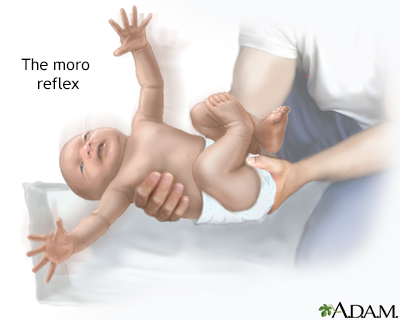Moro reflex
Startle response; Startle reflex; Embrace reflex
A reflex is a type of involuntary (without trying) response to stimulation. The Moro reflex is one of many reflexes that are seen at birth. It normally goes away after 3 or 4 months.
Images


Considerations
Your baby's health care provider will check for this reflex right after birth and during well-child visits.
To see the Moro reflex, the child will be placed face up on a soft, padded surface.
The head is gently lifted with enough support to just begin to remove the body weight from the pad. (Note: The infant's body should not be lifted off the pad, only the weight removed.)
The head is then released suddenly, allowed to fall backward for a moment, but quickly supported again (not allowed to bang on the padding).
The normal response is for the baby to have a startled look. The baby's arms should move sideways with the palms up and the thumbs flexed. The baby may cry for a minute.
As the reflex ends, the infant draws its arms back to the body, elbows flexed, and then relaxes.
Causes
This is a normal reflex present in newborn infants.
Absence of the Moro reflex in an infant is abnormal.
- Absence on both sides suggests damage to the brain or spinal cord.
- Absence on only one side suggests either a broken shoulder bone or an injury to the group of nerves that run from the lower neck and upper shoulder area into the arm may be present (these nerves are called brachial plexus).
A Moro reflex in an older infant, child, or adult is abnormal.
What to Expect at Your Office Visit
An abnormal Moro reflex is most often discovered by your provider. Your provider will perform a physical exam and ask about the child's medical history. Medical history questions may include:
- History of the labor and birth
- Detailed family history
- Other symptoms
If the reflex is absent or abnormal, further tests may need to be done to examine the child's muscles and nerves. Diagnostic tests, in cases of decreased or absent reflex, may include:
- Shoulder x-ray
- Tests for disorders associated with brachial plexus injury
Related Information
Infant reflexesTraction
References
Herring JA. The orthopaedic examination: a comprehensive overview. In: Herring JA, ed. Tachdjian's Pediatric Orthopaedics. 6th ed. Philadelphia, PA: Elsevier; 2022:chap 3.
Schor NF. Neurologic evaluation. In: Kliegman RM, St. Geme JW, Blum NJ, Shah SS, Tasker RC, Wilson KM, eds. Nelson Textbook of Pediatrics. 21st ed. Philadelphia, PA: Elsevier; 2020:chap 608.
Volpe JJ. Neurological examination: normal and abnormal features. In: Volpe JJ, Inder TE, Darras BT, et al, eds. Volpe's Neurology of the Newborn. 6th ed. Philadelphia, PA: Elsevier; 2018:chap 9.
BACK TO TOPReview Date: 11/6/2023
Reviewed By: Neil K. Kaneshiro, MD, MHA, Clinical Professor of Pediatrics, University of Washington School of Medicine, Seattle, WA. Also reviewed by David C. Dugdale, MD, Medical Director, Brenda Conaway, Editorial Director, and the A.D.A.M. Editorial team.

Health Content Provider
06/01/2025
|
A.D.A.M., Inc. is accredited by URAC, for Health Content Provider (www.urac.org). URAC's accreditation program is an independent audit to verify that A.D.A.M. follows rigorous standards of quality and accountability. A.D.A.M. is among the first to achieve this important distinction for online health information and services. Learn more about A.D.A.M.'s editorial policy, editorial process and privacy policy. A.D.A.M. is also a founding member of Hi-Ethics. This site complied with the HONcode standard for trustworthy health information from 1995 to 2022, after which HON (Health On the Net, a not-for-profit organization that promoted transparent and reliable health information online) was discontinued. |
The information provided herein should not be used during any medical emergency or for the diagnosis or treatment of any medical condition. A licensed medical professional should be consulted for diagnosis and treatment of any and all medical conditions. Links to other sites are provided for information only -- they do not constitute endorsements of those other sites. © 1997- 2024 A.D.A.M., a business unit of Ebix, Inc. Any duplication or distribution of the information contained herein is strictly prohibited.
